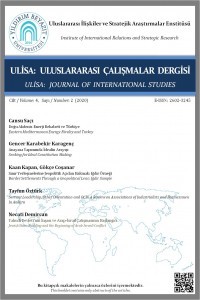Ekolojik Hareketten Siyasi Popülizme: Alman Yeşil Parti Örneği
Ekolojist partiler hem amaçları hem de örgütlenme biçimleri bakımından diğer siyasi partilerden ayrılırlar. Geleneksel siyasi parti tanımına uymayan bu partilerin, baskı grubu ve siyasi parti sınıflandırmasına giren yönleri de bulunmaktadır. Dünyada ilk yeşil parti 1972'de Yeni Zelanda'da kurulmuştur. Avrupa'da ise ilk yeşil parti Halk Partisi adıyla Birleşik Krallıkta 1973 yılında faaliyete geçmiştir. Bu parti 1987'de adını Yeşil Parti olarak değiştirmiştir.
Anahtar Kelimeler:
Ekoloji, Yeşil Politika, Alman Yeşil Parti, Popülizm, Başarısızlık
From Ecological Movement to Political Populism: German Green Party Example
party, also have a tendency to belong to the pressure group and to the political party classification. The first green party in the world was established in New Zealand in 1972. In Europe, the first green party was in operation in 1973 in the United Kingdom under the name of the People's Party. This party changed its name to Green Party in 1987.
Keywords:
Ecology, Green Policy, German Green Party, Populism, Failure,
___
- Arjomand, S. Amir, “The Arab Revolution of 2011 and Its Counterrevolutions in Comparative Perspective”, Arjomand (ed.) The Arab Revolution of 2011, Albany, SUNY Press, 2015.
- Arjomand, Said Amir (ed.), The Arab Revolution of 2011: A Comparative Perspective, Albany, SUNY Press, 2015.
- Batatu, Hanna, “The Egyptian, Syrian and Iraqi Revolutions: Some Observations on Their Underlying Causes and Social Character”, Inaugural Lecture, Center for Contemporary Arab Studies, Georgetown University, 25 January 1983.
- Beinin, Joel and Frederic Vairel (eds.), Social Movements, Mobilization, and Contestation in the Middle East, Sandford, Sandford University Press, 2011.
- Burr, J. Millard and Robert O. Collins, Revolutionary Sudan: Hasan al-Turabi and the Islamist State, 1989-2000, Leiden, Brill, 2003.
- Camila Pastor de Maria y Campos, “Revolt and Revolution in the Middle East: 1830-2012”, Regions and Cohesion, Vol.8, No.3, 2018.
- Cohen, Ronen A., Upheavals in the Middle East: The Theory and Practice of A Revolution, Lanham, Lexington Books, 2014.
- Cole, Juan, “Egypt’s Modern Revolutions and the Fall of Mubarak”, Gerges (ed.), The New Middle East: Protest and Revolution in the Arab World, New York, Cambridge University Press, 2014.
- Çetinkaya, Y. Doğan (ed.), Ortadoğu: Direniş, Devrim, Emperyalizm, İstanbul, İletişim Yay., 2014.
- Çetinkaya, Y. Doğan (ed.), Toplumsal Hareketler: Tarih, Teori, Deneyim, İstanbul, İletişim, 2014.
- Foran, John, “Discourses and Social Forces: The Role of Culture and Cultural Studies in Understanding Revolutions”, J. Foran (ed.), Theorizing Revolutions, London, Routledge, 1997.
- Foran, John, Taking Power: On the Origins of Third World Revolutions, New York, Cambridge University Press, 2005.
- Gerges, Fawaz A. (ed.), The New Middle East: Protest and Revolution in the Arab World, New York, Cambridge University Press, 2014.
- Goldstone, Jack A., “Bringing Regimes Back In: Explaining Success and Failure in the Middle East Revolts of 2011”, in S. Amir Arjomand (ed.) The Arab Revolution of 2011, Albany, SUNY Press, 2015. Goldstone, Jack A., “Toward a Fourth Generation of Revolutionary Theory”, Annual Review of Political Science, Vol.4, No.1, 2001.
- Goodwin, Jeff and Theda Skocpol, “Explaining Revolutions in the Contemporary Third World”, Politics & Society, Vol. 17, No. 4, 1989.
- Göçer Akder, Derya, “Theories of Revolutions and Arab Uprisings: The Lessons from the Middle East”, Ortadoğu Etütleri, Vol 4, No 2, 2013.
- Halliday, Fred, Revolution and Foreign Policy: The Case of South Yemen 1967-1987, Cambridge, Cambridge University Press, 1990.
- Hatto, A.T., “The Semantics of ‘Revolution’”, P.J. Vatikiotis (ed.), Revolution in the Middle East and Other Case Studies, New Jersey, Rowman and Little Field, 1972.
- Huntington, Samuel P., Political Order in Changing Societies, New Haven, Yale University Press, 2004.
- Kamrava, Mehran, “Revolution Revisited: the Structuralist-Voluntarist Debate”, Canadian Journal of Political Science, Vol. 32, No 2, 1999.
- Kansu, Aykut, The Revolution of 1908 in Turkey, Leiden, Brill, 1997.
- Lewis, Bernard, “Islamic Concepts of Revolution”, Vatikiotis (ed.), Revolution in the Middle East and Other Case Studies, New Jersey, Rowman and Little Field, 1972.
- Lewis, Bernard, “Islamic Revolution”, The New York Review of Books, vol. 34, no. 21-22, 1988, http://www.nybooks.com/articles/1988/01/21/islamic-revolution/ .
- Martin, Vanessa, Iran Between Islamic Nationalism and Secularism: The Constitutional Revolution of 1906, London, I.B. Tauris, 2013.
- Milani, Mohsen E., The Making of Islamic Revolution: From Monarchy to Islamic Republic, 2n ed., Boulder, Westview Press, 1994; Fred Halliday, The Iranian Revolution: Uneven Development and Religious Populism”, Journal of International Affairs, Vol.36, No.2, 1982/83.
- Skocpol, Theda, “Rentier State and Shi’a Islam in the Iranian Revolution,” Theory and Society, Vol.11, No.3, 1982.
- Skocpol, Theda, States and Social Revolutions: A Comparative Analysis of France, Russia and China, New York, Cambridge University Press, 1979.
- Sohrabi, Nader, Revolution and Constitutionalism in the Ottoman Empire and Iran, New York, Cambridge University Press, 2011.
- Tilly, Charles, From Mobilization ro Revolution, New York, Random House, 1978.
- Trimberger, Ellen K., “A Theory of Elite Revolutions,” Comparative International Development, Vol.7, No.3 1972. Yilmaz, Hakan, “The Kemalist Revolution and the Foundation of the One Party Regime”, in ro Dr Ergun z udun a rmağan – ilt , iyaset ilimi Essays in onor o Ergun z udun, Vol. I Political Science), ed. Serap Yazıcı, Kemal Go zler, Fuat Keyman, Ankara, Yetkin Yayınevi, 2008.
- Trimberger, Ellen K., Revolution from Above: Military Bureacrats and Development in Japan, Turkey, Egypt and Peru, New Brunswick, Transaction Books, 1978.
- Tripp, Charles, The Power and the People: Paths of Resistance in the Middle East, New York, Cambridge University Press, 2013.
- Vatikiotis, P.J. (ed.), Revolution in the Middle East and Other Case Studies, New Jersey, Rowman and Little Field, 1972.
- Başlangıç: 2017
- Yayıncı: Ankara Yıldırım Beyazıt Üniversitesi
Sayıdaki Diğer Makaleler
Misyonerlik Faaliyetleri ve Misyonerliğin Teopolitik Boyutları
Ekolojik Hareketten Siyasi Popülizme: Alman Yeşil Parti Örneği
Ortadoğu’da Az Çalışılmış Bir Konu Olarak Devrim
Oryantalizm ile Feminizm Arasında Türkiye’deki Kadın Yazarların Eserleri
Doğu-Batı İlişkilerinde Ortantalizmin Hz. Muhammed İçin Kullandığı Kavramların Rolü
